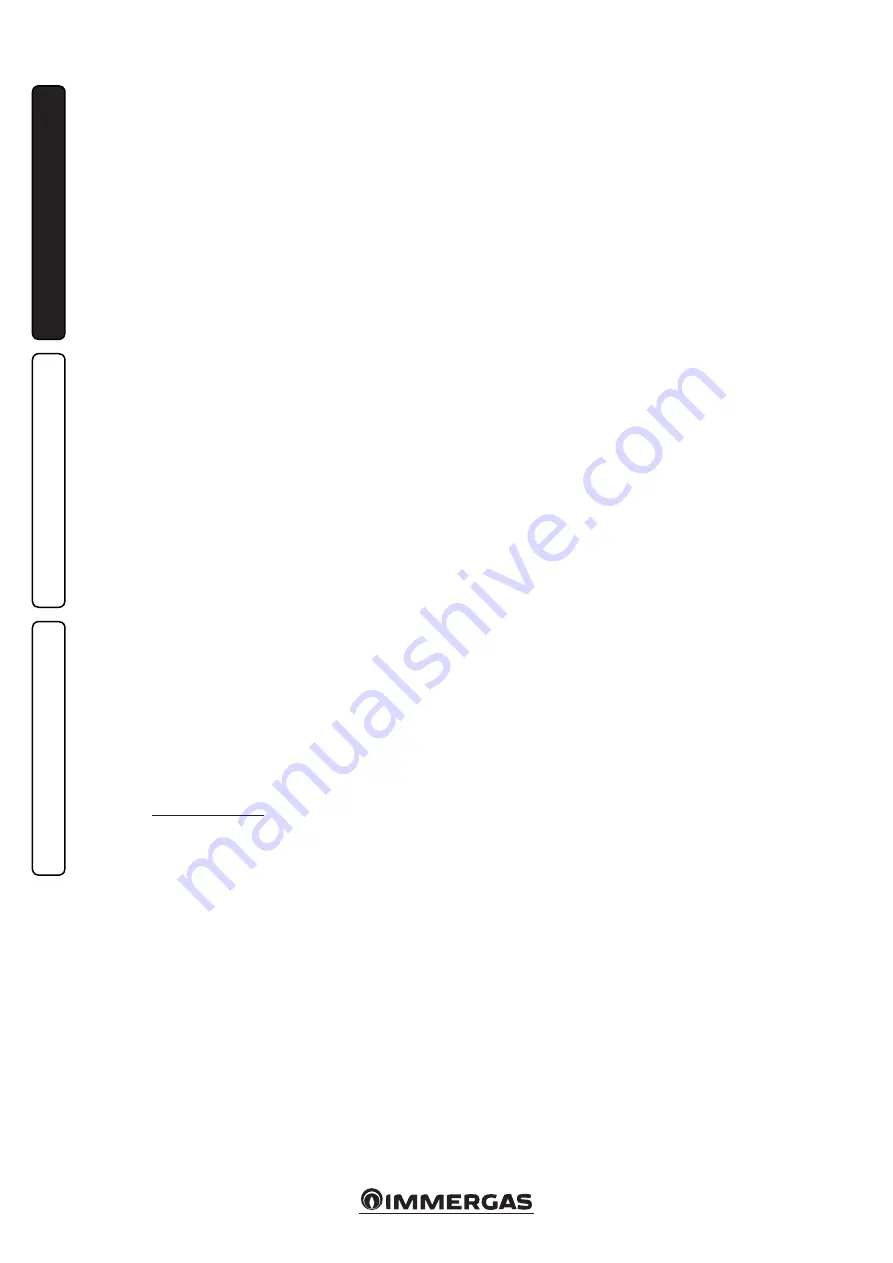
16
INS
TALLER
US
ER
MAINTEN
AN
CE TECHNI
CI
AN
1.10 FLUE EXHAUST TO FLUE/CHIMNEY.
Flue gas exhaust does not necessarily have to be
connected to a branched type traditional flue.
The flue exhaust can be connected to a special
LAS type multiple flue. Multiple and combined
flues must be specially designed according to
the calculation method and requirements of the
standards, by professionally qualified technical
staff. Chimney or flue sections for connection
of the exhaust pipe must comply with requisites
of technical standards in force.
1.11 DUCTING OF EXISTING FLUES.
With a specific “ducting system” it is possible
to reuse existing flues, chimneys and techni-
cal openings to discharge the boiler flue gases.
Ducting requires the use of ducts declared to be
suitable for the purpose by the manufacturer.
Follow the installation and user instructions
provided by the manufacturer and the require-
ments of standards.
1.12 FLUES, CHIMNEYS AND CHIMNEY
CAPS.
The flues, chimneys and chimney caps for the
evacuation of combustion products must be in
compliance with applicable standards.
Positioning the draught terminals.
The draught
terminals must:
- be installed on external perimeter walls of the
building;
- be positioned according to the minimum dis-
tances specified in current technical standards.
Combustion products exhaust of fan assisted
appliances in open-top closed environments.
In spaces closed on all sides with open tops
(ventilation pits, courtyards etc.), direct flue gas
exhaust is allowed for natural or forced draught
gas appliances with a heating power range from
4 to 35 kW, provided the conditions as per the
current technical standards are respected.
1.13 SYSTEM FILLING.
Once the boiler is connected, proceed with sys-
tem filling via the filling valve (Fig. 2-2).
Filling is performed at low speed to ensure release
of air bubbles in the water via the boiler and
heating system vents.
The boiler has a built-in automatic venting valve
on the pump.
Check if the cap is loose.
Open the radiator air vent valves. Close radiator
vent valves only when water escapes from them.
Close the filling valve when the boiler manometer
indicates approx. 1.2 bar.
N.B.:
during these operations turn on the circula-
tion pump at intervals, by means of the stand-by/
summer winter switch positioned on the control
panel.
Vent the circulation pump by loosening the
front cap and keeping the motor running.
Tighten the cap after the operation.
1.14 GAS SYSTEM START-UP.
To start up the system proceed as follows:
- open windows and doors;
- avoid presence of sparks or naked flames;
- bleed all air from pipelines;
- check that the internal system is properly sealed
according to specifications.
1.15 BOILER START-UP (IGNITION).
For issue of the envisioned Declaration of Con-
formity, the following must be performed for
boiler start-up:
- check that the internal system is properly sealed
according to specifications;
- make sure that the type of gas used corresponds
to boiler settings;
- switch the boiler on and check correct ignition;
- make sure that the gas flow rate and relevant
pressure values comply with those given in the
manual (par. 3.18);
- ensure that the safety device is engaged in the
event of gas supply failure and check activation
time;
- check activation of the main switch located
upstream from the boiler;
- check that the intake/exhaust concentric ter-
minal (if fitted) is not blocked.
The boiler must not be started up even if only
one of the checks should be negative.
N.B.:
the boiler preliminary check must be carried
out by a qualified technician. The conventional
boiler warranty is valid as of the date of testing.
The test certificate and warranty is issued to the
user.
Summary of Contents for MINI EOLO 28 3E
Page 1: ...MINI EOLO 28 3E Instruction and warning booklet IE 1 038767ENG ...
Page 2: ......
Page 28: ...28 3 5 4 4 5 6 6 d d c INSTALLER USER MAINTENANCE TECHNICIAN ...
Page 32: ...32 ...
Page 33: ...33 ...
Page 34: ...34 ...
Page 35: ...35 ...
















































